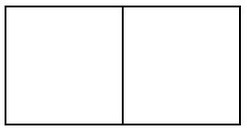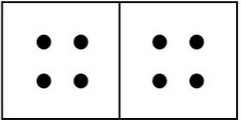1.2: Tema B- Conteo
- Page ID
- 127579
\( \newcommand{\vecs}[1]{\overset { \scriptstyle \rightharpoonup} {\mathbf{#1}} } \)
\( \newcommand{\vecd}[1]{\overset{-\!-\!\rightharpoonup}{\vphantom{a}\smash {#1}}} \)
\( \newcommand{\dsum}{\displaystyle\sum\limits} \)
\( \newcommand{\dint}{\displaystyle\int\limits} \)
\( \newcommand{\dlim}{\displaystyle\lim\limits} \)
\( \newcommand{\id}{\mathrm{id}}\) \( \newcommand{\Span}{\mathrm{span}}\)
( \newcommand{\kernel}{\mathrm{null}\,}\) \( \newcommand{\range}{\mathrm{range}\,}\)
\( \newcommand{\RealPart}{\mathrm{Re}}\) \( \newcommand{\ImaginaryPart}{\mathrm{Im}}\)
\( \newcommand{\Argument}{\mathrm{Arg}}\) \( \newcommand{\norm}[1]{\| #1 \|}\)
\( \newcommand{\inner}[2]{\langle #1, #2 \rangle}\)
\( \newcommand{\Span}{\mathrm{span}}\)
\( \newcommand{\id}{\mathrm{id}}\)
\( \newcommand{\Span}{\mathrm{span}}\)
\( \newcommand{\kernel}{\mathrm{null}\,}\)
\( \newcommand{\range}{\mathrm{range}\,}\)
\( \newcommand{\RealPart}{\mathrm{Re}}\)
\( \newcommand{\ImaginaryPart}{\mathrm{Im}}\)
\( \newcommand{\Argument}{\mathrm{Arg}}\)
\( \newcommand{\norm}[1]{\| #1 \|}\)
\( \newcommand{\inner}[2]{\langle #1, #2 \rangle}\)
\( \newcommand{\Span}{\mathrm{span}}\) \( \newcommand{\AA}{\unicode[.8,0]{x212B}}\)
\( \newcommand{\vectorA}[1]{\vec{#1}} % arrow\)
\( \newcommand{\vectorAt}[1]{\vec{\text{#1}}} % arrow\)
\( \newcommand{\vectorB}[1]{\overset { \scriptstyle \rightharpoonup} {\mathbf{#1}} } \)
\( \newcommand{\vectorC}[1]{\textbf{#1}} \)
\( \newcommand{\vectorD}[1]{\overrightarrow{#1}} \)
\( \newcommand{\vectorDt}[1]{\overrightarrow{\text{#1}}} \)
\( \newcommand{\vectE}[1]{\overset{-\!-\!\rightharpoonup}{\vphantom{a}\smash{\mathbf {#1}}}} \)
\( \newcommand{\vecs}[1]{\overset { \scriptstyle \rightharpoonup} {\mathbf{#1}} } \)
\( \newcommand{\vecd}[1]{\overset{-\!-\!\rightharpoonup}{\vphantom{a}\smash {#1}}} \)
\(\newcommand{\avec}{\mathbf a}\) \(\newcommand{\bvec}{\mathbf b}\) \(\newcommand{\cvec}{\mathbf c}\) \(\newcommand{\dvec}{\mathbf d}\) \(\newcommand{\dtil}{\widetilde{\mathbf d}}\) \(\newcommand{\evec}{\mathbf e}\) \(\newcommand{\fvec}{\mathbf f}\) \(\newcommand{\nvec}{\mathbf n}\) \(\newcommand{\pvec}{\mathbf p}\) \(\newcommand{\qvec}{\mathbf q}\) \(\newcommand{\svec}{\mathbf s}\) \(\newcommand{\tvec}{\mathbf t}\) \(\newcommand{\uvec}{\mathbf u}\) \(\newcommand{\vvec}{\mathbf v}\) \(\newcommand{\wvec}{\mathbf w}\) \(\newcommand{\xvec}{\mathbf x}\) \(\newcommand{\yvec}{\mathbf y}\) \(\newcommand{\zvec}{\mathbf z}\) \(\newcommand{\rvec}{\mathbf r}\) \(\newcommand{\mvec}{\mathbf m}\) \(\newcommand{\zerovec}{\mathbf 0}\) \(\newcommand{\onevec}{\mathbf 1}\) \(\newcommand{\real}{\mathbb R}\) \(\newcommand{\twovec}[2]{\left[\begin{array}{r}#1 \\ #2 \end{array}\right]}\) \(\newcommand{\ctwovec}[2]{\left[\begin{array}{c}#1 \\ #2 \end{array}\right]}\) \(\newcommand{\threevec}[3]{\left[\begin{array}{r}#1 \\ #2 \\ #3 \end{array}\right]}\) \(\newcommand{\cthreevec}[3]{\left[\begin{array}{c}#1 \\ #2 \\ #3 \end{array}\right]}\) \(\newcommand{\fourvec}[4]{\left[\begin{array}{r}#1 \\ #2 \\ #3 \\ #4 \end{array}\right]}\) \(\newcommand{\cfourvec}[4]{\left[\begin{array}{c}#1 \\ #2 \\ #3 \\ #4 \end{array}\right]}\) \(\newcommand{\fivevec}[5]{\left[\begin{array}{r}#1 \\ #2 \\ #3 \\ #4 \\ #5 \\ \end{array}\right]}\) \(\newcommand{\cfivevec}[5]{\left[\begin{array}{c}#1 \\ #2 \\ #3 \\ #4 \\ #5 \\ \end{array}\right]}\) \(\newcommand{\mattwo}[4]{\left[\begin{array}{rr}#1 \amp #2 \\ #3 \amp #4 \\ \end{array}\right]}\) \(\newcommand{\laspan}[1]{\text{Span}\{#1\}}\) \(\newcommand{\bcal}{\cal B}\) \(\newcommand{\ccal}{\cal C}\) \(\newcommand{\scal}{\cal S}\) \(\newcommand{\wcal}{\cal W}\) \(\newcommand{\ecal}{\cal E}\) \(\newcommand{\coords}[2]{\left\{#1\right\}_{#2}}\) \(\newcommand{\gray}[1]{\color{gray}{#1}}\) \(\newcommand{\lgray}[1]{\color{lightgray}{#1}}\) \(\newcommand{\rank}{\operatorname{rank}}\) \(\newcommand{\row}{\text{Row}}\) \(\newcommand{\col}{\text{Col}}\) \(\renewcommand{\row}{\text{Row}}\) \(\newcommand{\nul}{\text{Nul}}\) \(\newcommand{\var}{\text{Var}}\) \(\newcommand{\corr}{\text{corr}}\) \(\newcommand{\len}[1]{\left|#1\right|}\) \(\newcommand{\bbar}{\overline{\bvec}}\) \(\newcommand{\bhat}{\widehat{\bvec}}\) \(\newcommand{\bperp}{\bvec^\perp}\) \(\newcommand{\xhat}{\widehat{\xvec}}\) \(\newcommand{\vhat}{\widehat{\vvec}}\) \(\newcommand{\uhat}{\widehat{\uvec}}\) \(\newcommand{\what}{\widehat{\wvec}}\) \(\newcommand{\Sighat}{\widehat{\Sigma}}\) \(\newcommand{\lt}{<}\) \(\newcommand{\gt}{>}\) \(\newcommand{\amp}{&}\) \(\definecolor{fillinmathshade}{gray}{0.9}\)Tema B: Conteo
Para aprender a leer, primero hay que aprender las letras del alfabeto. Una vez que conoces el alfabeto, juntas las letras para hacer palabras, luego oraciones, luego párrafos y luego historias.
Esas letras se convierten en las “herramientas” utilizadas para escribir todo.
Lo mismo ocurre con las matemáticas. En matemáticas utilizamos dígitos. Los dígitos son:
0 1 2 3 4 5 6 7 8 9
Los dígitos llevan el nombre de nuestros dedos. Nuestros dedos también se llaman dígitos. El término matemático viene de los días de contar con nuestros dedos. Tenemos diez dedos y hay diez dígitos. Usamos las letras del alfabeto para componer palabras, y usamos dígitos para componer números. Hay dos formas de escribir números. Puedes escribirlos como números. Puedes escribirlos usando nombres de palabras.
| Numeral | Nombre de la palabra |
|---|---|
| 0 | cero |
| 1 | uno |
| 2 | dos |
| 3 | tres |
| 4 | cuatro |
| 5 | cinco |
| 6 | seis |
| 7 | siete |
| 8 | ocho |
| 9 | nueve |
Contar es hacer coincidir el nombre del número con las cosas que se están contando. Se ve un tazón de manzanas sobre la mesa. Quieres saber cuántas manzanas hay en el bol. Respondes esa pregunta diciendo: “Hay una, dos, tres, cuatro manzanas”. Estás dando los nombres de los números “uno”, “dos”, “tres” y “cuatro” a las manzanas. El último número que dices es el número total de manzanas.
Ejercicio 1
Cuenta el número de formas en cada imagen. Después escribe el numeral y el nombre de la palabra. Consulta tu trabajo usando la clave de respuesta al final del ejercicio.
| Imagen | Contestar |
|---|---|
 |
Número: 3
Nombre de la palabra: Three |
|
|
Número:
Nombre de la palabra: |
|
|
Número:
Nombre de la palabra: |
|
|
Número:
Nombre de la palabra: |
|
|
Número:
Nombre de la palabra: |
|
|
Número:
Nombre de la palabra: |
|
|
Número:
Nombre de la palabra: |
|
|
Número:
Nombre de la palabra: |
|
|
Número:
Nombre de la palabra: |
- Respuestas al Ejercicio 1
-
a. 2, dos
b. 6, seis
c. 8, ocho
d. 9, nueve
e. 1, uno
f. 5, cinco
g. 7, siete
h. 4, cuatro
Aquí están los números del uno al diez.
| 1 | 2 | 3 | 4 | 5 | 6 | 7 | 8 | 9 | 10 |
Practica escribirlas a continuación.
Ahora practica escribir los números del uno al diez en lo siguiente. Intenta hacerlas sin mirar. Consulta tu trabajo usando la clave de respuesta al final del ejercicio.
a.
| 1 | 3 | 5 | 7 | 9 |
b.
| 2 | 4 | 6 | 8 | 10 |
c.
| 1 | 4 | 7 |
d.
| 3 | 6 | 9 |
- Respuestas al Ejercicio 2
-
a.
-
2 4 6 8 10 b.
1 3 5 7 9 c.
2 3 5 6 8 9 10 d.
1 2 4 5 7 8 10
Autoprueba del Tema B
Marca/18 Objetivo 15/18
- Cuenta el número de cosas en cada imagen, luego escribe el número y el nombre de la palabra.
- Escribe los números del uno al diez.
- Respuestas al Autoexamen del Tema B
-
- 0, cero
- 6, seis
- 8, ocho
- 9, nueve
-
1 2 3 4 5 6 7 8 9 10
Cheque de Emociones
¿Cómo te sientes?
- ¿Tus palmas están húmedas?
- ¿Cómo es tu respiración?
Toma el control. Sé el jefe. Si te sientes ansioso, practica tu ejercicio de respiración.
Recuerda: Respira lentamente a la cuenta de cuatro. Sosténgalo por la cuenta de cuatro.













